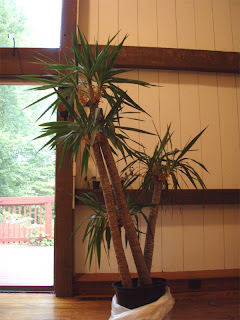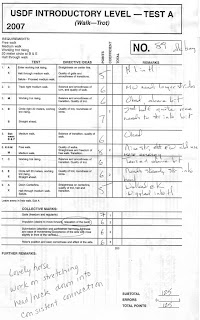Here is Part 4 of my series "Surviving your first dressage test". You can read the other parts so far here:
Here you are at the ShowIn this entry I'm going to give you a walk-through of what to expect. My final entry will be a wrap-up.
Hurray, you have arrived at your first dressage show! Congratulate yourself and your horse!ArrivalIf possible try to arrive at least 2 hours before your first test. Yes, I'm sorry to tell you that even the best run horse shows are a lot like airports. Expect lots of paperwork, misplaced baggage, delays, and trailers taxiing around the tarmac. But fortunately, you can leave your shoes on and there are no closed door "searches".

Personally, I like shows where I can arrive the day before and school my horse. Then I pay to stable him overnight. The extra expense is worth it for the chance to unload and school before the real action starts. But overnight stabling often fills up quickly.
Before you unload your horse, you'll want to "check-in" with the Show Secretary at the Show Office. They will ask you for any paper work they need and let you know if you've forgotten to pay any fees. Next they will give you your horse's number, and a show program and information. Your horse must wear her number at all times on show grounds, except when she is trailered or stalled. Now that you are checked-in you can go ahead and unload.
Checking things outAfter you get your horse situated, take a little time to stroll around on your own. Take note of the warm-up area, the ring you'll ride your test in, and the bathrooms. Note what starting signal your ring uses: is it a whistle, or a bell? Find the Ring Steward for your ring. They'll be the person with a clip-board, a pen, and a walky-talky. Think of him as a flight attendant. If you'll be riding your test soon, ask him if the ring is running on schedule. Also, if you plan to have a friend read your test to you, ask about the rules. (I'll discuss "readers" and other tidbits in the wrap up.) Next you may want to hand walk or ride your horse around these areas, except into the bathrooms of course.
Warm-upFinally, ride over to the warm-up area. You know your horse, so plan on warming up
just long enough for her to feel limber, but not tired. For my guy, we need 20 minutes before our first test, and 10 minutes before our second test on the same day. Any more and he'll be too tired for his second test, any less and he'll be stiff for his first.

When you arrive in the warm-up area, check in with that Ring Steward (
Yup, every ring has a different Steward). She'll confirm your number, name, ring, and time with you. Check with her if things are on schedule. When it's 5 minutes before your scheduled test, the Steward will let you know. Then you should head over to your ring.
Here we goWhen you get to your ring, let your Ring Steward know you are ready. There may be other riders still ahead of you. I like to just sit back and enjoy their tests. When it's your turn, he'll let you know. Ask him if you may warm-up inside the ring, until they blow the whistle. Usually this is allowed and it's a good opportunity for you and your horse to see the judge. You'll have about 2 minutes. Enter the ring, and walk over to the judges' booth. You'll see one or two judges, and a scribe, who will be frantically writing. Say "Good Morning!" and once everyone can give you their attention say "We're number 98, Jane Smith riding Floyd's Fuzzy Navel." They will thank you, and usually let you know that you've got "about a minute" before they blow the whistle. At this point, they're making sure they've finished the paperwork for the previous ride and starting your paperwork. Continue to ride around the ring. Try some loops, try both directions, but keep it simple. The judge will blow the whistle when she's ready. Now you have 45 seconds to exit the ring, and begin your test.
Your testYay! Your first test! How long have you spent working for this moment? Try to save the waterworks until after you are finished though. I managed not to blubber until after the final
halt at X. So now the judge has whistled you. You must exit the ring, and re-enter.
As soon as you re-enter, your test has officially begun. Try to ride the test like you are at home. Remember to prepare for transitions, ride into the corners, and
breath and
smile. You'll be amazed how few riders smile during their test.

So even if you aren't feeling it, go ahead and force a smile on your face to break the mold. Other than that, you've probably gotten more professional riding advice from someone else, so I'll spare you. But if you'd like some
tips on what judges look for, see here.
Very suddenly, your test will be finished! Walk your horse on a loose rein directly up to the judge.
Tell her "Thank you!". She will probably share some quick feedback with you right away. Listen well and try to remember the pointers she gives you. You'll also get written notes on your test later. When she's finished, thank her again and walk on a loose rein out of the arena. The next team will already be entering to warm-up.
Cool-downIf you've got another test today, you know the drill now, just rinse and repeat. Otherwise
it's time to relax! Get your horse situated. When every horse and rider in your class has finished, the
scores and placings will be posted at the Show Office. The office will also have a copy of your test.

Your scribe will have written down your judge's comments. They'll probably be in short-hand. If you have trouble interpreting them, ask a friend or another competitor to help you figure them out (the judge is usually too busy).
The comments are really valuable. Some judges tend to score everyone high or low, but the comments will give you insight into what she saw. As you ride before more judges, you'll find you get some of the same comments. Strongly consider those repeat comments.
Here is a scoring guide.Stroll around the show and watch some other tests. Feel free to clap after a test has finished. Compliment other riders and ask them about their horse. We all love to talk about our horse!
Enjoy the rest of your day at the show! Congratulations!Coming soon, the final wrap-up entry. It will cover rules, readers, etc.










































